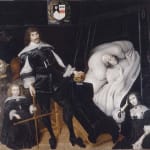 Fig. 1
John Souch (1594 – 1645)
Fig. 1
John Souch (1594 – 1645)Sir Thomas Aston at the Deathbed of His Wife
Oil on canvas: 203.2 x 215.1 cm., painted 1635.
Manchester Art Gallery (1927.150).
John Souch (1594 – 1645)
Provenance
By family descent to
Beilby Lawley (1849 – 1912), 3rd Baron Wenlock; to his daughter
The Hon. Irene Constance Lawley (1889 – 1976); to her daughter-in-law
Vivian Forbes-Adam (1921 – 2002); by whom sold to
Thomas Agnew & Sons, London; bt. by
George Gibbs (1928 – 2001), 2nd Baron Wraxall of Tyntesfield;[1] thence by descent at Tyntesfield, North Somerset; until their sale
Christie’s, 26 November 2002, lot 6; where acquired by
The Weiss Gallery, London; until 2004, when acquired by
Private collection, United States of America.
[1] His mother was the Hon. Ursula Lawley, daughter of Sir Arthur Lawley, 6th and last Baron Wenlock.
Literature
The Weiss Gallery, Icons of Splendour, London 2004, cat. 15.
The Weiss Gallery, Tudor and Stuart Portraits, London 2012, cat. 12.
John Souch was one of the most intriguing portrait painters working in provincial northwestern England prior to the outbreak of the Civil War. Here, he depicts the sitter, whose new husband was a highly successful drapery merchant, who had been based between London, the Low Countries, and Shropshire, sumptuously attired in all her finery, beneath richly draped curtains, a conceit that by this date was well established for courtly and later for aspirational portraiture. Of particular note is the timepiece, which hangs upon a ribbon attached to her bodice; it could reflect Souch’s native city of Chester’s significance as one of the earliest centres of watchmaking, with the first ‘watch-smith’ recorded there in 1602. Both the watch and the rings seen here are elements likewise found in Souch’s marriage portrait of An Unknown Couple from 1640, now in the Grosvenor Museum, Chester. Shropshire is a neighbouring county of Cheshire so it makes sense that the Lawleys, who were of sufficient means and clearly interested in displaying items that would prove their material wealth, would make great efforts in sourcing valuable accessories from local specialists and, likewise, patronise the most desirable local artists, such as Souch, to paint their portraits.
The artist has painstakingly painted the sitter’s conspicuously chosen accessories, extravagant statements of her wealth and status. His ‘neat and careful’ technique, ‘especially of costume details’, is particularly apparent, as is his use of ‘soft white highlights blended to give an almost shiny look to the flesh’.[1] Lady Lawley’s lace collar is fastened by three silk pansies studded with pearls, and a bejewelled and enamelled locket with golden putti hangs across the collar. A heavy agate necklace is looped over her shoulders and bodice, and the slashed silk sleeves reveal an under-garment embroidered with carnations. A diamond ring hangs from a black mourning thread, precariously perched on her right sleeve; the ring magnificently defies gravity, its placement a pure nod to artistic license and iconographical significance. Her hands and wrists are bejewelled, and in her left she holds an ostrich feather fan, while the right rests on a small, beautifully bound book, presumably a bible, and some elaborately trimmed gloves. Here is a woman who wishes to leave the viewer in no doubt as to her social standing.
Lady Lawley, née Anne Manning (c.1600 – 1666), was the daughter and co-heir of John Manning of Hackney, Middlesex and Cralle in Sussex. In 1625, the year this portrait was likely painted, she married Sir Thomas Lawley (1580/83 – 1646), 1st Bt., of Spoonhill, Salop. Thomas was a “Merchant Adventurer”, who traded goods – in particular Spanish cloth - between England and the Low Countries. Although based in London, he inherited the Spoonhill estate from his elder brother in 1624 and became an MP for Wenlock in 1625 – 1626 and 1628 – 1629. Their eldest son, Sir Francis Lawley (c.1626 – 1696), succeeded to the baronetcy in 1646 and, like his father, became an MP for Wenlock. After Sir Thomas’s death in 1646, Anne remarried Sir John Glynn (1602 – 1666), Lord Chief Justice of the Upper Bench in 1655. She died in 1666 and was buried with her parents in London.
Born to a Lancashire draper in 1594, John Souch was apprenticed to Randle Holme, the famous founder of a Chester dynasty of genealogists and heralds, from 1607 – 1617. It was from Holme that Souch learned his earliest skills, including painted coats-of-arms, genealogical rolls, and wooden memorial tablets. Following his apprenticeship, he became a Freeman of Chester and a member of the Chester Painters and Stationers Company. His years with Holme gave him an introduction to the predominantly Royalist Cheshire and North Wales gentry, who became Souch’s main patrons. Indeed, Holme was responsible for the order of the funeral for Lady Aston, whose death is commemorated in Souch’s large and mysterious masterpiece, a memento mori depicting Sir Thomas Aston at the deathbed of his wife, 1635 [Fig. 1]. Souch died suddenly in 1645, and may have been killed during the Siege of Chester, for like his former master Holme, he was a staunch Royalist supporter.
[1] See J. Treuherz, “New Light on John Souch of Chester” from The Burlington Magazine, London (May 1997), p.302.


